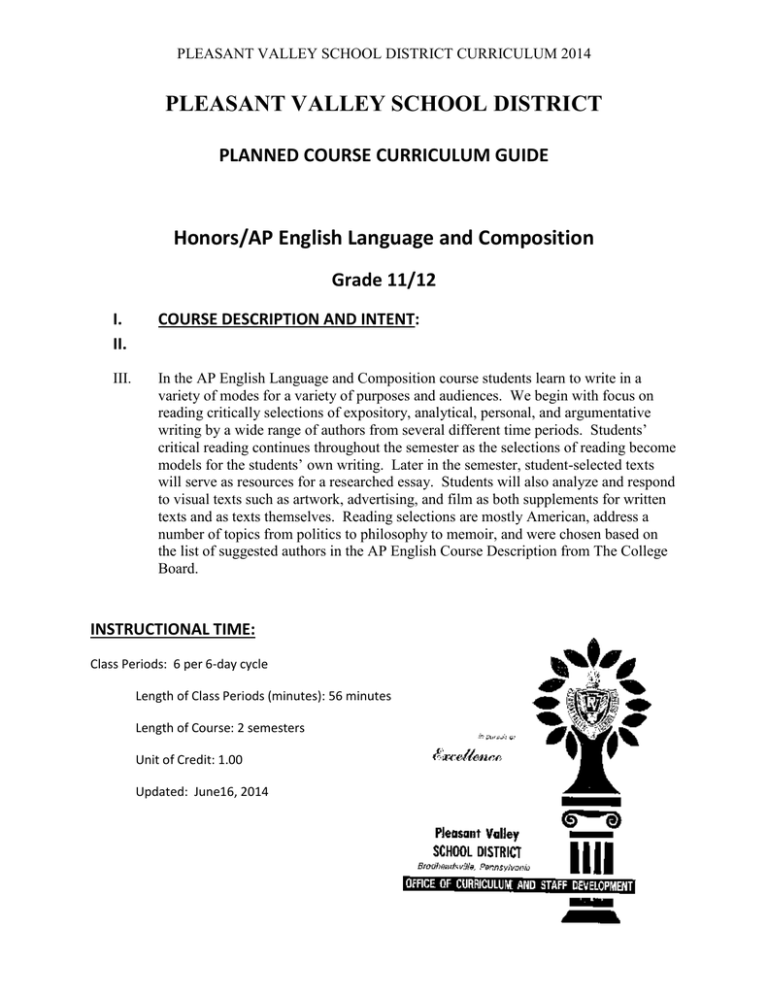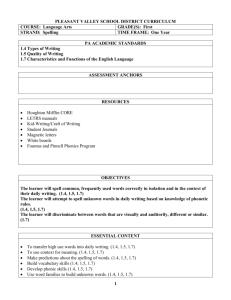AP English Language and Composition
advertisement

PLEASANT VALLEY SCHOOL DISTRICT CURRICULUM 2014 PLEASANT VALLEY SCHOOL DISTRICT PLANNED COURSE CURRICULUM GUIDE Honors/AP English Language and Composition Grade 11/12 I. II. COURSE DESCRIPTION AND INTENT: III. In the AP English Language and Composition course students learn to write in a variety of modes for a variety of purposes and audiences. We begin with focus on reading critically selections of expository, analytical, personal, and argumentative writing by a wide range of authors from several different time periods. Students’ critical reading continues throughout the semester as the selections of reading become models for the students’ own writing. Later in the semester, student-selected texts will serve as resources for a researched essay. Students will also analyze and respond to visual texts such as artwork, advertising, and film as both supplements for written texts and as texts themselves. Reading selections are mostly American, address a number of topics from politics to philosophy to memoir, and were chosen based on the list of suggested authors in the AP English Course Description from The College Board. INSTRUCTIONAL TIME: Class Periods: 6 per 6-day cycle Length of Class Periods (minutes): 56 minutes Length of Course: 2 semesters Unit of Credit: 1.00 Updated: June16, 2014 PLEASANT VALLEY SCHOOL DISTRICT CURRICULUM 2014 COURSE: Honors/AP English Language and Composition STRAND: Literature GRADE(S): 11/12 TIMEFRAME: One Year PA ACADEMIC STANDARDS 1.1. Learning to Read Independently 1.2. Reading Critically in All Content Areas 1.3. Reading, Analyzing and Interpreting Literature 1.7. Characteristics and Functions of the English Language 1.9. Information, Communication, and Technology Literacy ASSESSMENT ANCHORS R11.A.2 Understand nonfiction appropriate to grade level R11.B.1 Understand components within and between texts R11.B.2 Understand literary devices in fictional and nonfiction text R11.B.3 Understand concepts and organization of nonfiction text RESOURCES Textbook: Prentice Hall Reader, AP Edition Textbook: Everyday Use: Rhetoric at Work in Reading and Writing Textbook: 100 Great Essays Teacher created materials Teacher selected materials Major Works: Reading Lolita in Tehran Fast Food Nation Sesame and Lilies Fahrenheit 451 or Brave New World The Crucible or Frankenstein The Things They Carried or The Canterbury Tales The Awakening or Beowulf One Flew Over the Cuckoo’s Nest or Hamlet The Great Gatsby Visual Text: The Village, a film by M. Night Shyamalan Vocabulary lists Tools for Teaching Content Literacy English Department Wiki Page – http://pvenglish.wikispaces.com Pleasant Valley High School Library Website http://webpages.pvbears.org/hslibrary/index.htm Online discussion group Teacher Faculty Web Page PLEASANT VALLEY SCHOOL DISTRICT CURRICULUM 2014 OBJECTIVES The Learner Will: Read, comprehend, interpret, analyze, and evaluate four major works (1.1.11.A,D; 1.2.11.A-E; 1.3.11.A-D; 1.7.11; 1.9.11.A) Read, comprehend, and respond to essential content across all genres (1.2.11.A,B,C,E; 1.9.11.A,B) Analyze literary elements and devices (1.3.11.A-D) Analyze inferences and conclusions based on and related to an author’s implicit and explicit assumptions and beliefs about a subject (1.2.11.D) Use context clues, knowledge of root words, and word origins as well as reference sources to decode and understand new words (1.1.11.B) Apply meaning and knowledge of words and their relationships to other words across content areas (1.1.11.C) Demonstrate an appropriate rate of silent reading based upon specific grade level texts (1.1.11.E) Analyze the role and place of standard American English in speech, writing, and literature (1.7.11) ESSENTIAL CONTENT Explore the following Essential Questions: How does knowledge of rhetorical strategies inform both reading and writing? What is the relationship between writer, context, audience, and argument? What are the different rhetorical modes and when is each used? How is a new argument synthesized? Read, comprehend, interpret, analyze, and evaluate rhetorical elements in Reading Lolita in Tehran, Sesame and Lilies, In Cold Blood, and Fast Food Nation Compare various nonfiction genres to each other and to major works as PLEASANT VALLEY SCHOOL DISTRICT CURRICULUM 2014 they relate to rhetoric Identify and analyze: appeal, argument, arrangement, audience, connotation, cultural memory, delivery, denotation, ethos, genre, invention, language, logos, occasion, pathos, persona, purpose, rhetoric, speaker, subject, style, syntax, tone Research, read, and present a critical analysis of a major work of Western philosophy Address 20-30 vocabulary words within context of major works Provide time for sustained silent reading and/or explicit literacy instruction INSTRUCTIONAL STRATEGIES Introduce and explore Essential Questions Incorporate the use of supplemental essays, memoir, biographies, articles, and visuals for exploring Essential Questions and analyzing rhetorical relationships Model analysis and evaluation of rhetorical strategies in short works and in major works as follows: context, arrangement, and purpose in Reading Lolita in Tehran occasion, delivery, and juxtaposition in Sesame and Lilies invention, genre, and syntax in In Cold Blood persona, cultural memory, and exemplification in Fast Food Nation Utilize think alouds, talking to the text, metacognitive reflections, double entry journals, the question game, anticipation guides, SOAPSTone, Yes/No But, and Triangle of Appeals ASSESSMENTS Tests and quizzes Portfolios Journals Essays and papers Teacher observed question/answer sessions PLEASANT VALLEY SCHOOL DISTRICT CURRICULUM 2014 Homework CORRECTIVES/EXTENSIONS Correctives: Explicit modeling followed by systematic, guided practice of each skill Incorporate reading apprenticeship activities Extensions: Integrate technology Student-generated authentic projects and/or discussions PLEASANT VALLEY SCHOOL DISTRICT CURRICULUM 2014 COURSE: Honors/AP English Language and Composition STRAND: Writing GRADE(S): 11/12 TIMEFRAME: One Year PA COMMON CORE STANDARDS 1.4 Writing Students write for different purposes and audiences. Students write clear and focused text to convey a well-defined perspective and appropriate content. ASSESSMENT ANCHORS C.E.1.1 Write informative pieces that describe, explain, or summarize information or ideas. C.P.1.1 Write persuasive pieces that include a clearly stated position made convincing through appropriate methods. C.E.2.1 Revise writing to improve style, meaning, word choice, and sentence variety. C.E.3.1 Use conventions of standard written language. RESOURCES AP Central Web Site AP Free Response Essay Prompts Textbook: Prentice Hall Reader, AP Edition Textbook: Everyday Use: Rhetoric at Work in Reading and Writing Teacher created/selected materials Student selected materials College Board Writing Rubric pdesas.org OBJECTIVES The Learner Will: Prepare an inquiry-based research paper that synthesizes an argument, following discipline-specific research format and documentation, using information, organizational skills, primary and secondary sources, and traditional and PLEASANT VALLEY SCHOOL DISTRICT CURRICULUM 2014 emerging library technologies Reflect on and self-evaluate writing Develop a comprehensive writing portfolio Respond to AP argument and analysis prompts in a timed setting Respond to AP style synthesis prompts in formal short papers Develop arguments with consideration of audience, purpose, and subject. Construct analyses of classic and contemporary writing Develop and practice style using various writing strategies ESSENTIAL CONTENT Timed essays Synthesis papers Examination of a variety of argument constructs Writing in the nine rhetorical modes: argumentation, exemplification, compare-contrast, narration, division-classification, process analysis, causeeffect, description, and definition Differentiate between active and passive voice and use each appropriately Recognize different points of view and use appropriately Recognize the use of persona and be able to develop one Be able to self-evaluate writing and use evaluation for improving writing INSTRUCTIONAL STRATEGIES Examine, discuss, and evaluate several examples of synthesis research questions and responses Examine, discuss, and evaluate several examples of analysis questions and responses Examine, discuss, and evaluate several examples of argument questions and responses Model various forms of note taking Explicitly teach a variety of methods of constructing argument Explicitly teach writing a proper analysis Peer review Reference individual research planner checklists for classroom and library activities PLEASANT VALLEY SCHOOL DISTRICT CURRICULUM 2014 ASSESSMENTS Timed essays Formal short papers Culminating research paper Homework assignments Teacher directed verbal review Student self-evaluations Portfolios CORRECTIVES/EXTENSIONS Correctives: Explicit modeling followed by systematic, guided practice of each skill Reinforcements of skills Re-teaching Extensions: Provide opportunity for further inquiry Convert research paper into technology-enhanced research presentation Apply research to authentic, real-world scenarios PLEASANT VALLEY SCHOOL DISTRICT CURRICULUM 2014 COURSE: Honors/AP English Language and Composition STRAND: Speaking & Listening GRADE(S): 11/12 TIMEFRAME: One Year PA ACADEMIC STANDARDS 1.6. Speaking and Listening 1.7. Characteristics and Functions of the English Language 1.9. Information, Communication, and Technology Literacy ASSESSMENT ANCHORS RESOURCES Teacher created materials Student selected materials Yale University Rethinking the Western Tradition Web pages Project Guggenheim Web pages Supplemental texts English Department Wiki Page – http://pvenglish.wikispaces.com Pleasant Valley High School Library Website http://webpages.pvbears.org/hslibrary/index.htm OBJECTIVES Demonstrate speaking skills formally and informally (1.6.11.A,B; 1.7.11) Demonstrate critical listening skills (1.6. 11.A) Integrate technology to encourage critical thinking and student engagement (1.9. 11.A) Deliver a formal speech that adheres to the standards for formal presentation (1.6. 11.A,B; 1.7.11) Participate in small and large group discussions, presentations, and question/answer sessions to hone skills in speaking and listening within group settings (1.6. 11.A,B; 1.7.11) PLEASANT VALLEY SCHOOL DISTRICT CURRICULUM 2014 ESSENTIAL CONTENT Present a formal speech of at least 8 minutes on a Western philosopher and philosophical text from the series Rethinking the Western Tradition Deliver at least one informal/impromptu speech of at least 4 minutes that explains a rhetorical strategy Take accurate notes during discussions and presentations Utilize notes to prepare for and generate classroom discussions INSTRUCTIONAL STRATEGIES Lecture Technology presentations Discussion forums Group problem-solving Modeling Integrate Technology and 21st Century Skills ASSESSMENTS Notebook quizzes following lectures and presentations Discussion journals Teacher formal and informal observations Teacher and peer reviews PLEASANT VALLEY SCHOOL DISTRICT CURRICULUM 2014 CORRECTIVES/EXTENSIONS Correctives Explicit modeling followed by systematic, guided practice of each skill Extensions Student generated debates, discussions, presentations, and/or question/answer session PLEASANT VALLEY SCHOOL DISTRICT CURRICULUM 2014 COURSE: Honors/AP English Language and Composition STRAND: Research 1.2. 1.4. 1.8. 1.9. GRADE(S): 11/12 TIMEFRAME: One Year PA ACADEMIC STANDARDS Reading, Analyzing, and Interpreting Text Types of Writing Research Information, Communication, and Technology Literacy ASSESSMENT ANCHORS RESOURCES AP Central Web Site Textbook: Prentice Hall Reader, AP Edition Textbook: Everyday Use: Rhetoric at Work in Reading and Writing Language Arts Task Force Research and Assessment Guide MLA Handbook PVHS Library web pages and links Library Research Planner Student selected materials College Board Writing Rubric OBJECTIVES The Learner Will: Prepare an inquiry-based research paper, following MLA, APA, or Chicago format and documentation, using information, organizational skills, primary and secondary sources, and traditional and emerging library technologies (1.4.11.B,C; 1.8.11.A,B,C; 1.9.11.A) Differentiate fact from opinion across a variety of texts by using complete and accurate information, coherent arguments, and points of view (1.2.11.B) Distinguish between essential and nonessential information across a variety of sources, identifying the use of proper references or authorities and propaganda PLEASANT VALLEY SCHOOL DISTRICT CURRICULUM 2014 techniques where present (1.2.11.C) ESSENTIAL CONTENT Follow the process for conducting research of: compiling a working bibliography, evaluating sources, taking notes, outlining, and writing drafts Develop, with teacher guidance, an essential question Answer the essential question to formulate a thesis statement that addresses purpose and audience During the research process, submit a working annotated bibliography for the purpose of review by teacher and possible revision by student Differentiate between summarizing, paraphrasing, direct quoting, and using one’s own ideas to prevent intentional and unintentional plagiarism Use a variety of tools to produce an individual researched essay on a studentselected topic with a minimum of six sources and five pages Plan and incorporate a minimum of three library visits INSTRUCTIONAL STRATEGIES Examine, discuss, and evaluate several examples of synthesis research questions and responses The classroom teacher and librarians will collaborate and co-teach throughout the process of planning, conducting, and documenting research Model various forms of note taking Peer review Reference individual research planner checklists for classroom and library activities ASSESSMENTS Teacher and peer evaluation The final paper Pre-research activities PLEASANT VALLEY SCHOOL DISTRICT CURRICULUM 2014 CORRECTIVES/EXTENSIONS Correctives: Explicit modeling followed by systematic, guided practice of each skill Extensions: Provide opportunity for further inquiry Convert research paper into technology-enhanced research presentation Apply research to authentic, real-world scenarios




